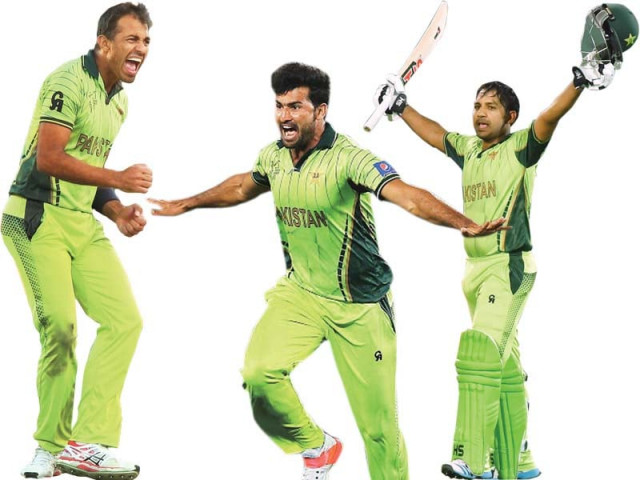

If there was one player who improved his reputation in the World Cup then it was Wahab Riaz, who finished with 16 wickets.
The strongly-built pacer also batted well against Zimbabwe with an important half-century, which allowed Pakistan to registers their first win. He was also a handy fielder, unlike the other pacers.
Wahab’s ferocious spell against Australia will be remembered for a very long time, bullying the likes of Michael Clarke, Shane Watson and Glenn Maxwell only to be let down by the fielders. It has taken Wahab almost six years to realise his potential and now that he has, fans will be hoping that he continues to deliver consistently.
Sarfraz Ahmed

After being dropped for the first few matches, Sarfraz showed none of the signs of nerves that the others did.
Deemed not good enough to open Down Under, Sarfraz’s courageous run-a-ball 49 against South Africa provided the missing impetus at the top. He also took six catches to equal Adam Gilchrist’s world record and bag the man of the match on his World Cup debut.
He followed that up with his maiden ODI century against Ireland and received his second man-of-the-match award.
However, he got out early against Australia and Pakistan failed to get the decent start they wanted from their in-form batsman, who finished with 160 runs in three matches.
Misbahul Haq

Skipper Misbahul Haq has been one of the only constants of the side in the last four years and once again showed his importance to the side with consistent displays.
Four fifties in seven outings and 350 runs at an average of 50 is testament to his assured batting. His captaincy was also impressive as he marshalled his troops and allowed his fast bowlers to excel with attacking field placements and bowling changes.
However, at the risk of being too harsh, his inability to convert scores and his low scoring rate at the start can be criticised. Misbah will also be disappointed with the way he was dismissed against Australia.
Muhammad Irfan

The tallest man in the game’s history was able to extract some precious bounce from the pitches Down Under and was often a wicket-taking threat, especially with the new ball.
After some steasy but unspectacular performances in the first two matches, Irfan was just starting to get into his groove with impressive back displays against Zimbabwe and South Africa, where he took wickets at crucial times to sway the match in Pakistan’s favour, before he was ruled out of the tournament with a stress fracture.
Considering the bounce on offer at the Adelaide Oval, Irfan proved to be a big miss for the Pakistanis, especially considering the way Wahab bowled.
Rahat Ali

It is unfortunate that Rahat’s campaign will be defined by the crucial dropped catch of Shane Watson.
But before that match, and that drop, Rahat had been brilliant with the ball as he moved it both ways and provided crucial breakthroughs, while showing great control to bowl economically. Brought into the side after Yasir Shah’s failure in the first game against India, Rahat complimented the other three pacers well and bowled later on in tandem with Wahab.
The third left-armer of the four-man pace attack certainly proved his critics wrong with the ball and it would be harsh to blame him for Pakistan’s elimination due to that one piece of poor fielding.
Ahmed Shehzad

Shehzad, the new poster boy of Pakistan cricket, consumed too many dot balls at the start, and hence often proved to be a source of frustration. He scored 227 in seven matches at an average of 32.42, and was below par considering his usual high standards. The 23-year-old was often found wanting at the start of the innings and his only two half-centuries came against the two weakest bowling attacks he faced — the UAE and Ireland.
He was dismissed against Australia playing away from his body without moving his feet and ended up edging it to the slips.
Haris Sohail

Haris has emerged as a good all-rounder and did not look out of place in Australia and New Zealand but neither did he come up with any noteworthy performances.
Promoted up the order and entrusted with the all-important one-down position, Haris impressed with the bat but never got going after getting starts. He will be particularly disappointed with the way he threw away his wicket against Australia, chasing a wide half-volley and nicking it to Brad Haddin when Pakistan needed him to stay at the crease.
He chipped in with the ball but needs to learn the value of his wicket if he wants to make a mark in international cricket.
Younus Khan

Younus was pushed up the order to open the innings against India but failed. He was also dismissed quickly against the West Indies as Pakistan were reduced to 4-1.
Then the inevitable happened and he was dropped against the UAE and Zimbabwe. He did come back against South Africa in place of the injured Haris and played an assured 37-run knock but would be disappointed in the way he was dismissed by the slow medium pacers of AB de Villiers, with the ball taking a leading edge as he tried to work it through to the on side.
That proved to be his last innings in the tournament as he made way for Haris, who recovered for the match against Ireland.
Umar Akmal

For all of his talent, Umar was one of the definitive failures of the campaign.
The 24-year-old made only one half-century, scoring 59 against the West Indies. Other than that, he was only able to score more than 20 once in six innings when he made 33 against Zimbabwe.
Umar will be especially disappointed with the way he threw away his wicket against Australia, pulling a rank long hop by Maxwell straight down Aaron Finch’s throat.
While he may still have a bright future for Pakistan, he needs to once again up the ante and perform in the big games.
Sohaib Maqsood

Sohaib, often compared to Inzamamul Haq, failed to live up to his predecessor from Multan and, like Umar, his only half-century came against the West Indies.
The 27-year-old was often selected for his ability to score quick runs and win the match on his own but failed to stay at the crease when the situation demanded it. He was the last batsman left standing against Australia but still slashed wildly at a ball outside off, only to hit it straight into the hands of the fielder in the circle. His failure to play the long haul and his knack of throwing away his wicket meant he was just as frustrating as the other two young middle-order men in the side — Haris and Umar.
Shahid Afridi

Fans of cricket, those supporting Pakistan and neutrals alike, would be disappointed with the way Shahid Afridi performed in his last ever tournament with both bat and ball.
While he did play important cameos, his highest score in the tournament was 28, with five of his six innings being in the 20s.
He also failed to take wickets, claiming only two in the entire tournament, both against the UAE opposition. The leg-spinner was unable to find the drift that accounts for most of his wickets
and was easily tackled by most batsmen.
Ehsan Adil

Brought in for the final two games as Irfan’s replacement, Ehsan took two wickets and gave away 62 runs in 12 overs, with figures of 1-31 against both Ireland (in seven overs) and Australia (in five overs).
The 22-year-old has the capability of being a good seamer for the future but was perhaps drafted too early into international cricket. While there is a lot of potential, some more time in domestic cricket would only help him get better and stronger.
He was also one of the poorest fielders in the side and looked woefully unfit.
Yasir Shah

He was being regarded as the Mushtaq Ahmed of 1992 but failed to live up to the billing.
His only World Cup outing was against India, in which he failed to take a single wicket and was expensive, giving away 60 runs in eight overs. He also dropped a difficult chance of Virat Kohli in that match, who went on to make a century.
However, he may consider himself unlucky for not being given another chance, especially in matches where the pitch seemed to support slow bowling.
Nasir Jamshed

Jamshed was called in as a replacement for the injured Muhammad Hafeez, but was one of the poorest players of the tournament, not only for Pakistan but overall.
He made 0, 1 and 4 in the three matches he played before being replaced by Sarfraz, with an average of 1.66 runs.
Perhaps even more disconcerting was the way he was dismissed in almost the same manner in all three matches, pulling the ball straight into the hands of the fielder inside the ring on the on side, despite the ball appearing to hit the middle of the bat
Sohail Khan

Sohail Khan was one of the refreshing new additions to the Pakistan squad, swinging both the new and the old ball.
Sohail was also tasked with the responsibility of bowling at the death and barring the West Indies game, lived up to the responsibility. His penchant for bowling at the end also meant his figures were unfairly expensive.
His five-wicket haul against India and the prized scalp of AB de Villiers made him an important member of the team but needs to improve his fielding if he wants to survive in international cricket, with his rigid upper body making him an incredibly ungainly fielder.
All ratings are out of 10 and all three former players have given their scores on a personal basis as experts.
Published in The Express Tribune, March 23rd, 2015.
Like Sports on Facebook, follow @ETribuneSports on Twitter to stay informed and join in the conversation.


















COMMENTS
Comments are moderated and generally will be posted if they are on-topic and not abusive.
For more information, please see our Comments FAQ